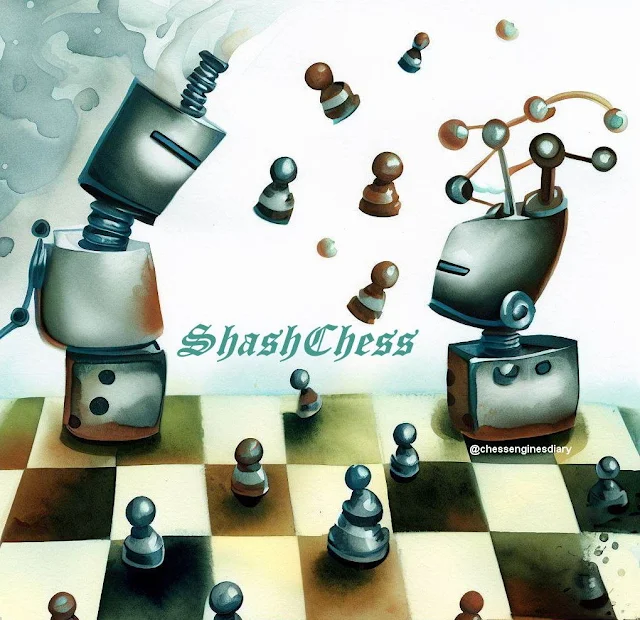Rating Chess Engines Diary CEDR=3758
We have great news. A new version of the ShashChess 39 chess engine has been released. This engine offers a completely new approach to analysis. We'll begin the first tests of ShashChess 39 today!
What is ShashChess? A Summary
ShashChess is a cutting-edge chess engine built on Stockfish that revolutionizes the chess approach.
Instead of relying solely on numerical evaluation, it integrates:
● The Shashin Zone Theory:
Classify each position according to a strategic style (e.g., Tal,
Capablanca, Petrosian) to dynamically adapt search behavior.
● WDL Probabilistic Model:
It goes beyond simple evaluation, estimating the probabilities
of Win, Draw, and Loss for a deeper understanding of positional nuances.
● MCTS Hybrid and Reinforced Learning:
Combine alpha-beta search with Monte
Carlo Tree Search (MCTS) and search learning for dynamic exploration and real-time
strategic adaptation.
ShashChess 39 what's new?
ShashChess 39 builds on the solid foundation of version 38, introducing crucial improvements that elevate its performance and strategic intelligence.
1. The Principle of Minimum Resilience: Thermodynamics on the Chessboard
The most profound innovation of ShashChess 39 is the introduction of the concept of minimum
resilience, a principle borrowed from thermodynamics, as suggested by Alexander Shashin in his book, for the management of chaotic positions, implemented in the new algorithmgandtResilientShashinRange().
A chess position is treated as a physical system where the engine, faced with a chaotic (high entropy) position, does not rely on a single evaluation, but simulates a "cooling" process to find the most efficient path to stability and advantage.
● Phase 1: High Energy Approach (Tal Style):The system explores the most aggressive and
tactical path first to see if a quick resolution can be forced.
● Phase 2: Decay to Stability (Capablanca Style):If the attack is inconclusive, the engine
reduces entropy seeking positional balance.
● Phase 3: Final Consolidation (Petrosian Style):If necessary, the system settles into the most
robust, lowest-energy state to consolidate its advantage.
This scientific approach allows ShashChess to handle chaos with superior resilience, finding the optimal strategy that fits the intrinsic nature of the position.
Technical Deep Dive: The Physical Model
● Entropy (S): It measures disorder and uncertainty. It is modeled as S∼=Σp(x)logp(x),
where p(x) is the probability distribution of the pieces over legal moves.
● Resilience (R):It is the ability to resist disturbances (threats). Conceptually defined as
R=E−T⋅S, where E is the strategic potential energy and T is the "tactical temperature".
● Practical Example:In one positionTal-Petrosian
(tactical chaos + solid defense),
ShashChess 39 evaluates whether a sacrifice is thermodynamically sustainable before run it.
2. Recognition of Fortresses and Preservation Logic
ShashChess 39 introduce un sophisticated algorithm for fortress recognition, positions in which one side, even at a material disadvantage, can force a draw. Thanks to the new flagtheFortress, the engine is now able to:
● Avoid unnecessary efforts in an attempt to win theoretically drawn positions.
● Playing for the fortress when he is at a disadvantage.
● Preserve the fortress during the ordering of moves, giving priority to moves that do not
weaken the defensive structure.
3. Shashin Framework Expansion: Adaptive Calibration
The Shashin positional model has been enhanced with finer calibration of the search extensions depending on the area:
● Hybrid Zones: More precise management of border areas such
asCapablanca-TalandCapablanca-Petrosian.
● Adaptive Margin Adjustment:The extension margins dynamically adapt to the position
style to optimize calculation time:
○ High Tall:More aggressive margins (-55/-75) to facilitate tactical research.
○ Capablanca:Strategic moderation (+45/+65) for positional search.
○ Petrosian:Defensive prudence (-25/-35) to consolidate the position.
4. Hybrid MCTS and Reinforcement Learning Enhanced
● MCTS Improved:The MCTS engine now includes a node limit (MCTSMaxNodes) to prevent
excessive memory use and better awareness of the danger to the king.
● Optimized Learning:The reward function has been improved to reward not only victory, but
also stability resilient, reducing the overestimation of speculative sacrifices.
Scientific Rigor: Testing Strategy and Results
To validate its progress, ShashChess 39 was rigorously tested against the Stockfish benchmark. The number of positions was specifically chosen to minimize statistical fluctuations.
● Test 1: Suite of 256 Complex Positions
○ Configuration:1 minute/position, single thread (to further reduce statistical noise).
○ Result: ShashChess 39: 138 solved positions vs. Stockfish: 134. Greater accuracy in
high entropy locations.
● Test 2: Match Series on 50 "Nuggets" Positions
○ Configuration:300 total games (3 reps), 4 threads per motor, on sharp and
unbalanced positions.
○ Result:Final score of+64 / =176 / -60 in favor of ShashChess 39.
Conclusion: Beyond Brute Force
With ShashChess 39, the engine evolves from a tactical powerhouse to a deeply strategic and adaptive system. Thanks to physics-inspired resilience modeling, fortress detection, and refined Shashin logic,
it confirms itself as a serious and original contribution to the landscape of modern chess engines.
We invite you to our social media:
X (Twitter): https://x.com/Aisaba10
Vivaldi (Mastodon): https://social.vivaldi.net/deck/@CEDR
Instagram: https://www.instagram.com/szachyizycie/

Comments
Post a Comment